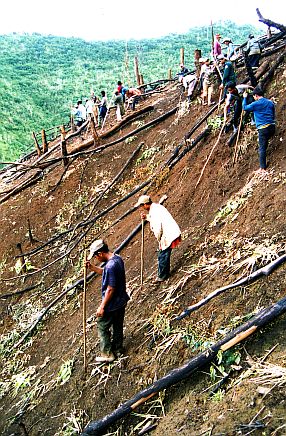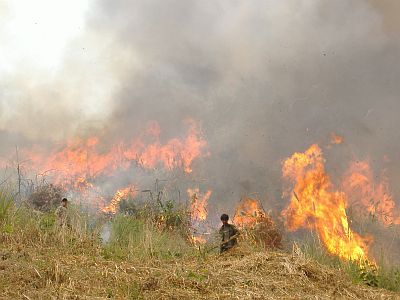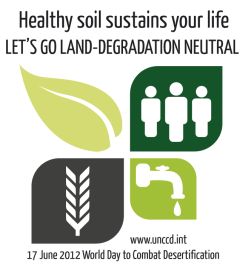World Day to Combat Desertification, 17th June. The theme for 2012 is: “Healthy soil sustains your life: Let’s go land-degradation neutral”
Soil erosion in Southeast Asia’s uplands can lead to serious land degradation. A new study suggests legislation limiting traditional shifting cultivation actually increases the erosion rates. Current polices on land-use planning should be reconsidered as they put significant burden on smallholder farmers.

Upland area after burning, Laos
Photo Credit: Alain Pierret, IRD
In the steep narrow valleys of the Houay Pano catchment, near the historic Laos city of Luang Prabang, farmers have cultivated the land in a traditional manner for centuries. Vegetation is burnt to clear areas for planting. Upland rice, maize and other crops are then sown on the plots. After harvesting the land is left fallow. Historically these fallow periods could last up to 30 years.
Even though 50 million farmers in Southeast Asia practice this kind of shifting cultivation, it has long been regarded as unnecessarily destructive and environmentally unsustainable. Burning off vegetation was thought to lead to increased deforestation and contribute to increased greenhouse gas emissions. Indeed, it has been official policy of the Food and Agriculture Organization of the United Nations (FAO) to discourage shifting cultivation in favor of a continuous sedentary approach since the first Earth Summit in Rio twenty years ago.
However, now it seems that traditional farmers may not only have had it right all along. A team of researchers from the French Institut de Recherche pour le Développement (IRD), in association with national partners and the International Water Management Institute (IWMI), undertook a detailed study of cropping patterns, soil erosion and water management in the Houay Pano catchment. Their results, recently published in the report, Reshaping upland farming policies to support nature and livelihoods, suggest that shifting cultivation may be less damaging to soil health than previously thought. Certainly in times of low land pressure, but even under increasing pressure, shifting cultivation is still better at preserving soil conditions than alternative land use systems.
“The slash-and-burn approach is favored by upland farmers as it releases nutrients into the soil and saves on costly fertilizer,” says Alain Pierret, the lead researcher. “Lao government policy, however, has reduced the amount of land that upland farmers can use. Farmers can’t afford to grow less crops, so they have little choice but to intensify their shifting cultivation patterns. However, chemical fertilizers are expensive. So, many start growing plantation crops, which, together with inappropriate understory management, result in higher erosion rates.”

Laos burning
Photo Credit: Alain Pierret, IRD
Current fallow periods on this site are now as low as 2-3 years. This is not due to population pressure that much, as the restrictions farmers face in their search for land. Farmers in the research sites complained that the shorter rotation schedules had led to increased soil erosion and reduced yields.
The IRD study showed that traditional shifting cultivation with a fallow period at least eight times longer that the cropping period, kept average sediment losses well within natural limits of soil regeneration. However, as land has been taken out of farming and converted to tree plantations, fallow periods have to be reduced if farmer income is to be maintained.
“Shifting cultivation militates against soil erosion, but only if there is alternative land allowing fallow periods long enough for soil regeneration,” says Pierret. “Policies which limit land access put a huge burden on farmers to maintain the fertility artificially. As this has its limits, it may be appropriate to start introducing incentives that support a shift to non-farm activities.”
The scientists also looked at the impact of extreme rainfall events which are becoming increasingly common as climate change takes hold. They noted that anti-erosion strategies have to account for those events, as they can easily double common annual erosion rates thereby leading to negative impacts not only for farmers but also hydropower dams downstream.
Pierret, A.; de Rouw, A.; Chaplot, V.; Valentin, C.; Noble, A.; Suhardiman, D.; Drechsel, P. 2011. Reshaping upland farming policies to support nature and livelihoods: lessons from soil erosion in Southeast Asia with emphasis on Lao PDR. [Report of the Management of Soil Erosion Consortium (MSEC) Project]. Marseille, France: Institut de Recherche pour le Developpment (IRD); Colombo, Sri Lanka: International Water Management Institute (IWMI). 40p.
June 17 is the World Day to Combat Desertification. The theme for 2012 is, “Healthy soil sustains your life: Let’s go land-degradation neutral.”
Source: http://www.iwmi.cgiar.org


